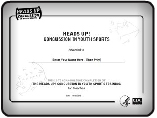

DOWNLOADABLE TOOLS — CONCUSSION INFORMATION
View CDC's “Heads Up” Concussion Educational Materials
“Heads Up” for youth sports coaches, administrators, and parents
“Heads Up” for high school coaches, athletic directors, athletic trainers, and parents
“Heads Up” for school nurses, parents, teachers, counselors, and other school professionals
“Heads Up” for health care professionals
Baseline Testing
FAQs on Baseline Testing Fact Sheet
Download a Fact Sheet on Overall Sports Safety: Protect the Ones You Love
Order Free Copies of CDC's “Heads Up” Educational Materials
Materials on Concussion in Sports
Materials for Health Care Providers
Materials for School Professionals
Learn More about the Brain and How it Works
Order Free Copies of CDC's “Heads Up” Educational MaterialsInteractive Brain [Exit Disclaimer]
Concussion Educational Materials for all NCAA Sports
Download Materials [Exit Disclaimer]
Watch a Video or PSA on Concussion
NFL PSA on Concussion Safety [Exit Disclaimer]
Keeping Quiet Can Keep You Out of the Game [Exit Disclaimer] [Movie: 2:00 minutes]
Read more about Tracy's Story [PDF 187KB]
Brandon's Story News segment from PBS News Hour with Jim Lehrer, which originally aired on January 26th, 2000.
For High School Coaches:
“Concussion in Sports: What You Need to Know,” [Exit Disclaimer]
Free Online Training (Developed in partnership with the National Federation of State High School Associations)
Listen to a Radio PSA
Coach and Team [Audio: 0:30 seconds]
Mom and Daughter [Audio: 0:30 seconds]
Announcers [Audio: 0:30 seconds]
Listen to a Podcast
Heads Up! Play It Safe When It Comes to Concussions! [Podcast: 6:49 minutes]
Heads Up! [Podcast: 0:59 seconds]; in Spanish [Podcast: 1:27 minutes]
Send a Health eCard
PROMOTIONAL MATERIALS
"Heads Up: Concussion in Youth Sports" flyer [PDF 104KB]
Slideshow [PDF 775KB]
Ordering Card [PDF 185KB]
Logo [PDF 50KB]
Flash Web:
Banner 1 [Exit Disclaimer]
Banner 2 [Exit Disclaimer]
Banner 3 [Exit Disclaimer]
Watch a Video or PSA on Concussion>
NFL PSA on Concussion Safety [Exit Disclaimer]
Keeping Quiet Can Keep You Out of the Game [Exit Disclaimer] [Movie: 2:00 minutes]
Read more about Tracy's Story [PDF 187KB]
Keeping Quiet Can Keep You Out of the Game... A Mother's Story [Exit Disclaimer] [Movie: 2:00 minutes]
Brandon's Story News segment from PBS News Hour with Jim Lehrer, which originally aired on January 26th, 2000. For High School Coaches: “Concussion in Sports: What You Need to Know,” [Exit Disclaimer] Free Online Training (Developed in partnership with the National Federation of State High School Associations) Coach and Team [Audio: 0:30 seconds] Mom and Daughter [Audio: 0:30 seconds] Teens [Audio: 0:30 seconds] Announcers [Audio: 0:30 seconds] Heads Up! Play It Safe When It Comes to Concussions! [Podcast: 6:49 minutes] Heads Up! [Podcast: 0:59 seconds]; in Spanish [Podcast: 1:27 minutes]Listen to a Radio PSA
Listen to a Podcast
Send a Health eCard
ORDER FREE PRINT COPIES OF CDC'S CONCUSSION RESOURCES
Order Free Copies of CDC's “Heads Up” Educational Materials
Materials on Concussion in Sports
Materials for Health Care Providers
Materials for School Professionals
Order Large Quantities of CDC's “Heads Up Educational Materials
To order bulk quantities of CDC's concussion resources free-of-charge contact CDC by email (CDC-INFO@cdc.gov) or toll-free at 1-800-CDC-INFO (1-800-232-4636).
Include the title of the publication, quantity requested, mailing address, and subject heading: “Concussion in Sports”)
VIDEOS FROM EXPERTS AND FOR MORE INFORMATION
Watch a Video or PSA on Concussion
NFL PSA on Concussion Safety [Exit Disclaimer]
Keeping Quiet Can Keep You Out of the Game [Exit Disclaimer] [Movie: 2:00 minutes]
Read more about Tracy's Story [PDF 187KB]
Keeping Quiet Can Keep You Out of the Game... A Mother's Story [Exit Disclaimer] [Movie: 2:00 minutes]
Brandon's Story News segment from PBS News Hour with Jim Lehrer, which originally aired on January 26th, 2000.
For High School Coaches:
“Concussion in Sports: What You Need to Know,” [Exit Disclaimer]
Free Online Training (Developed in partnership with the National Federation of State High School Associations)
GET MORE INFORMATION ON CONCUSSION and
TRAUMATIC BRAIN INJURY IN THE UNITED STATES
COMMUNICATING EFFECTIVELY ABOUT CONCUSSIONS
Communicating Effectively about Concussions [PDF 348KB]
DOWNLOAD SPORT-SPECIFIC CONCUSSION INFORMATION
Amateur Athletic Union
Amateur Softball Association/USA Softball
American Academy of Neurology
American Academy of Pediatrics
American Academy of Physical Medicine and Rehabilitation
American College of Sports Medicine
American Medical Society for Sports Medicine
American School Health Association
American School Health Association
American Sports Education Program
Brain Injury Association of America
Brain Trauma Foundation
Center for Injury Research and Policy, the Research Institute at Nationwide Children's Hospital
Children's National Medical Center
Defense and Veterans Brain Injury Center
Emergency Nurses Association
Health Resources and Services Administration, EMS for Children
Health Resources Services Administration, Traumatic Brain Injury Program
Massachusetts Department of Public Health
Matthew Alan Gfeller Sport-Related TBI
Research Center, University of North Carolina at Chapel Hill
May Clinic
MSU, Institute for the Study of Youth Sports
National Academy of Neuropsychology
National Alliance for Youth Sports
National Association of School Nurses
National Association of Secondary School Principals
National Council for Youth Sports
National Education Association
National Education Association Health Information Network
National Federation of State High School Associations
National Interscholastic Athletic Administrators Association
National Program for Playground Safety
National Recreation and Park Association
North American Brain Injury Society
Pop Warner Little Scholars, Inc.
President's Council on Physical Fitness and Sports
Safe Kids Worldwide
Safe States Alliance
Sarah Jane Brain Foundation
Society of State Directors of Health, Physical Education & Recreation
Sports Legacy Institute
University of Pittsburgh Medical Center, Sports Medicine Concussion Program
US Lacrosse
US Soccer
USA Baseball
USA Football
USA Rugby
USA Volleyball
YMCA of the USA

